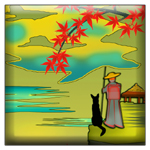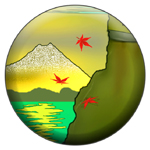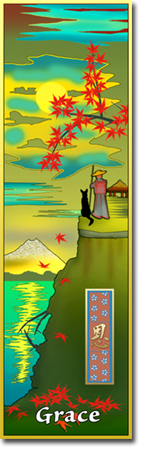On The Way: The Daily Zen Journal
Delusion and Zazen
Kosho Uchiyama (1912-1999)

The zazen taught in Zen Buddhism is the actualization of the Middle Way that is at the very quick of life; it is life as life—that is, life as interdependence. Zazen enables life to be life by letting it be.
One might well ask: Whether we exert ourselves or not, aren’t we always living life as it is? Isn’t it nonsense to speak of living apart from life? This is indeed so, and it is the basis of the Buddhist teaching that all beings have buddha nature. That is, actualizing life is our very nature.
Nevertheless, it is also true that we aren’t always living fully, we aren’t always actualizing our life. This is because unlike the flowers in the fields, human beings bear the burden of thought.
Thought has a dual nature: thought springs from life, and yet it has the ability to think of things totally ungrounded and detached from the fact of life. This is delusion, and it leads to some strange consequences.
Being detached by our thoughts from reality, we fabricate seemingly substantial and accumulable entities such as money, position, or power right in the middle of this insubstantial world.
This is the view of existence. In order to possess these things, we become greedy and deceitful, hating and injuring each other, or else we hold on to feelings of inferiority that develop into neuroses in the course of our struggle. Delusion is this very view of myself as an independent substantial entity.
Even though this world of interdependence is not substantial, provisionally it has a certain order. Yet, we ignore that order—taking up the view of nonexistence—and pursue selfish desires, throwing all our energy into killing one another and destroying the things around us, living for the moment and in the end short-circuiting our lives.
In other words, our thoughts, whether through the view of existence or nonexistence, become the basis for the distortions of our lives that prevent life from manifesting, in a straightforward way, as it truly is.
In Buddhism, thoughts as the foundation of these views of existence and nonexistence is referred to as ego-attachment. Ego-attachment is our clinging to “substance” and calling it I, which in our ignorance we have falsely constructed in the constantly shifting world of interdependence.

In other words, egocentricity lies at the basis of whatever we see or do. It tags along with us. Being dragged around by egocentric thought, our life cannot manifest directly and winds up pushed out of shape and disabled. This being dragged about by egocentric thought has been committed by humankind since its beginning. Adam and Eve truly put us in a mess.
I saw a fascinating cartoon in a newspaper some years ago. Adam was trying with all his might to vomit up something he had eaten. Eve was standing beside him with a worried expression, saying, “Adam, hasn’t that apple you ate come out yet?”
If only humanity could once and for all vomit up that indigestible green apple of ego-attachment. In a way, egocentric thought is a little like “original sin.” In Buddhism, true zazen is, in a sense, the posture of vomiting up that apple. But when did we eat the apple? It was by no means in some remote mythical past.
Here we are, merely interdependent existences, a collection of such accidental factors as heredity, the overall current of the times, and the social context in which we find ourselves. Without any good reason, moved by ignorance, we pompously stick a label onto this aggregation, call it I.

We firmly believe that this is our self; we cling to ego as though it simply existed in the natural order of things. Actually, outside of the power of ignorance, which causes attachment to the ego-self in each moment, where is that apple we ate? That apple is precisely what we are eating again in our attachment to ourselves.
Yet to vomit up this apple is no easy matter. Even if we understand that there is no reason to stick the label of “self” onto an aggregation of various coincidental factors and to get attached to this label, and if moreover, we understand that this attachment to ego is the source of various evils, delusions, and sufferings, and therefore ought to be vomited up—even if we understand all this, we still cannot vomit up this apple.
For our ego-attachment does not occur merely on the surface of consciousness; we are eating this apple prior to our conscious awareness—that is, in the depths of our subconscious. Indeed, it may well be that in our very desire to throw up the apple, the poison of the apple is at work. At this point, human intellect serves no purpose at all, for it is precisely using our head that is being called into question.
In the zazen posture, we are able to calm down, and our mental excitability diminishes. It is by nature a posture in which it is impossible to think continuously about the same thing, and the fictions we set up in our heads dissolve. Therefore, when doing zazen we just sit, letting go of everything that comes up.
All that has been learned is given back to learning. All that has been memorized is given back to memory. All that has been thought is given back to thought. To let go of everything—that is the posture of zazen.

When we are doing zazen, does this mean that thoughts no longer arise, and that our heads become empty? No, of course not. As long as we are alive it is only natural that various thoughts arise, even when we are doing zazen. What is crucial is to let them come and go of themselves without pursuing them or driving them out.
For example, a thought comes up: if we follow it, then we are thinking and no longer sitting zazen, even though we are in the zazen posture. In zazen, it is important not to chase after thoughts. On the other hand, when a thought comes up, should we try to wipe it out? If we do, then we end up thinking that we have to try to wipe out that thought. Rather, when doing zazen, we commit everything to the posture, without chasing after or chasing out thoughts.
In the same way, when we take the zazen posture, if we doze off we are napping and not doing zazen. Just as doing zazen is not thinking while sitting, neither is it napping or dozing off while sitting. Therefore, full of vigor, we just aim at the correct zazen posture with our flesh and bones. Just practicing this is doing zazen.
Moreover, it is of utmost importance here not to indulge in self-observation. Self-observation, or observing the effect of our zazen, such as being calmer or more agitated, not only misses the mark, but the moment we do so, we impair zazen and go off the track. Zazen has nothing to do with thinking about results. It is essential just to aim at the posture of zazen without trying to observe its effects.
You may feel that being unable to observe the effect of your zazen will lead to tremendous dissatisfaction. It is only natural to feel this, for zazen throws out our petty thoughts that seek satisfaction and manifests life purely as life. The feeling that something is lacking is no more than our petty thoughts of being unfulfilled.

Sawaki Roshi used to say,
“There is no reason to expect the reality of immeasurable and unbounded life to satisfy our puny little thoughts.”
Only when we let go of all such ideas will our life find peace in the purity of full life, because it is just these dissatisfied thoughts and our being tangled in ideas of existence or nonexistence that throw our lives into anxiety and drag us into suffering, fighting, hopelessness, and despair. It is through the posture of letting go of these thoughts that we are able to discover the absolute peace of life.
Nevertheless, this peace is not the cessation or extinction of life; it is not seclusion or escapism. Far from it. Living in peace is the unfettered realization of life as life and is not at all off in the clouds. Rather, all reality, undisturbed by thought, is reflected as it interdependently appears and disappears. Genuine peace is like a clear mirror that simply reflects all images as they are, without anything sticking to it.
Zazen is itself practicing the Middle Way with our own bodies. The Middle Way is itself true life. This can be seen in our daily lives as well. For example, when we are driving a car, if we are tense, or absorbed in our thoughts, our life becomes totally confused and we cannot manifest it as it is. Our driving becomes highly dangerous.
At the same time, it is hazardous to drive when sleepy or drunk, which also blinds us. We can drive safely only when we are relaxed and at the same time wide awake.
Zazen is the posture through which our life force manifests itself most naturally and purely.
Kosho Uchiyama (1912-1999)
Excerpted from Opening the Hand of Thought – Foundations of Buddhist Practice Kosho Uchiyama 2004





We can learn something from every teacher we meet through the journals. Some may be difficult to understand because their style seems archaic or the translator’s choice of words may lead to some confusion, but there are kernels of wisdom in every piece. That leaves us with the task of translating for ourselves what is usable in each reading. They are all trying to help guide us along the Way, and for a while, we can feel what it would be like to be their student.
Even if a teacher is from a different school with differing practices, the readings give us a chance to practice a new technique with an open mind and see what it has to offer. In this piece, Uchiyama uses powerful imagery that we might not associate with going beyond our sense of self. In this, though, he gets our attention as it represents the seemingly insurmountable task before us.
There are principles of Buddhism that seem self-evident, like impermanence, as we see it objectively through the passage of the seasons as well as our feelings which come and go. We also have all felt the power of being drawn to a person or object, then clinging and having to hold onto it.
Through meditation, we begin to have a platform to step back to, and the clinging lessens. There is almost a physical sensation when the mind is being pulled outwards due to desire or emotion. Recognizing that moment allows us to rein ourselves back into the calm place. Over time the pulls lessen and allow more mindful participation in life.
What is one of the most challenging notions expressed by Uchiyama is “Delusion is this very view of myself as an independent substantial entity.” This one is quite stubborn as we have a difficult time imagining living without a sense of ego.
It is a natural koan that no teacher has to give to us. However, we all experience times of no-self naturally throughout the day. When we are immersed in the present so deeply there are actions and perceptions that suggest on their own what to do next. There is often no need for a sense of self in that.
Perhaps the easiest way to get close to the experience of no-self is first to explore more of the “middle-way” sense of ego – just enough to participate without grasping, clinging, and a sense of nothing extra in the doing.
Reflecting on the next steps together,
Elana, Scribe for Daily Zen